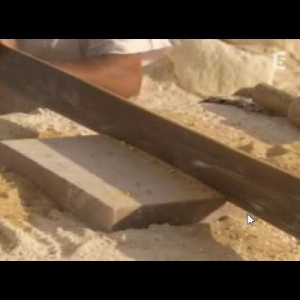♦Livre♦
Experiments in Egyptian Archaeology: Stoneworking Technology in Ancient Egypt
103. The working of stone with copper chisels and adzes, with flint chisels, punches, scrapers and adzes, and with grinding stones and stone hammers only supplied part of the craftworker’s capability to fashion all types of ancient stone artifacts. In order to enable ancient Egyptian artisans to create the range of objects demanded of them during the Late Predynastic and Dynastic periods, other technology required development. Often, modern technology evolves from earlier techniques and materials, and it is likely that such fundamental developments also occurred in ancient Egypt. Thus, two important tools for cutting the stones were added to the craftworker’s tool-kit, and these were the flat-ended copper tubular drill and the flat-edged copper saw, both used with a particulate abrasive. The tubular drill predated the invention of the stonecutting saw, which probably owed its development to the introduction of hard stone for architecture in the Early Dynastic and Old Kingdom periods. The stonecutting saw is a direct development of the serrated woodcutting saw, itself a development from the serrated flint knife and sickle. No examples of copper stonecutting tubes and saws have survived to the present day, nor have any tomb representations of them been found.
120. The two test arc-shaped bows are dissimilar in shape to the angled, or curved, woodworkers’ bow-shafts displayed in some tomb representations.52 Larger bows, which were needed for driving the large diameter tubular drills, have been lost to us like the drill-tubes they drove. These ancient bows may have been shaped like the woodworker’s bow, or arc-shaped, a design seen in certain Eighteenth Dynasty Theban tombs.5
A Brief History of Drills and Drilling
6. Archaeological excavations have not yet produced copper or bronze drills in a lapidary context. We have been able, however, to provide evidence for the use of copper drills. through several serendipitous findings. The first occurred during an examination of quartz cylinder seals whose drill-hole impressions disclosed a peculiar anomaly on the sidewall (Fig. 10). We produced this same phenomenon, which we called a collar (Gorelick and Gwinnett 1989), quite accidentally while drilling on glass using a copper rod, quartz abrasive, and water (Fig. 11 ). We hypothesized that this occurred through plastic deformation of the copper rod's leading edge as a result of frictional heat and downward pressure on the rod. The ancient craftsman created the collars unwittingly during the course of drilling. If he added loose abrasive and lubricant in inadequate quantity, the drilling advanced slowly. A ware of this, ·he may have consequently applied greater pressure on the palm rest, thus distorting the drill. As he continued to add abrasive, the flare on the drill disappeared, but not before it produced a characteristic groove in the sidewall of the drill hole (Fig. 10). This phenomenon is unique to copper and the presence of a collar in the perforation of a bead is evidence of the use of a copper drill.

